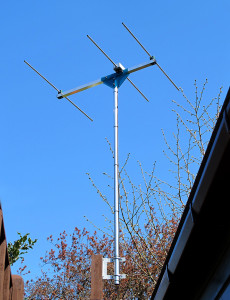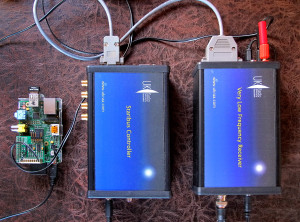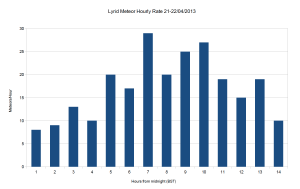April 27, 2013
Chirps and Chirrups – Radio Astronomy Group Meeting – 27 April 2013
Report by: Grey Lipley
Our meeting in the Endeavour Room, although long overdue, remains popular, with one new and eight existing members in attendance. I apologised for the length of time between meetings and explained how Mike Meynell and I intend to schedule more regular events. We envisage the Radio Group getting together formally every 2 months with more regular solar viewing sessions for those interested. We also hope to recruit additional members who will be qualified to call additional sessions when required.
Mike then provided a brief summary of our activities so far, most of which can be found in past meeting reports.
As a newly formed group we have mainly focused on two contrasting avenues of Radio Astronomy to achieve results. The first uses a Loop Aerial to obtain VLF information and has been highly successful thanks to Clive Inglis and the addition of purchased items such as an amplifier designed to indirectly record Sudden Ionospheric Disturbances (SIDs) induced by solar flares. The second method employs a satellite dish mounted on a HEQ5 mount to amplify VHF data.
Robin Gilbert has also experimented by blocking the ‘sound’ of the Sun by placing his hand between our nearest star and the receiver. Some of this material Robin presented at the BBC Stargazing Live event held at the NMM earlier this year. See also http://en.wikipedia.org/wiki/Radio_propagation
As part of a general catch up, I then gave an account of my surprise visit to the Norman Lockyer Observatory near Sidmouth in South Devon.
It was a wild and windy night as I made my way to the main dome with only a torch for company. Nearing the building I noticed a dull yellow glow from behind net curtains and knocked on a nearby door. I was fortunate that the lady who greeted me was the Chief Astronomer who, following my explanation, welcomed me inside. This was an entirely impromptu visit and my luck held, for on hearing about the formation of our Radio Astronomy Group, I was immediately introduced to Ian and Alan who head Radio Astronomy at the Observatory there. They were thrilled at the prospect of sharing information gathered by us and asked if we would be willing to use the same software for displaying joint material. They already do this with a number of Societies throughout the South of England and as a result have formed a vast and highly sensitive receiver. Before leaving, I promised I would put this to the Flamsteed Radio Astronomy Group for discussion.
At the Flamsteed meeting, this promoted a conversation about how best to manage data and how to store it. Clive asked whether the Flamsteed website had sufficient capacity. This was confirmed by Mike who added that the website is hosted in the “Cloud”, technically giving unlimited storage, with automatic back up of all our material. Although we entirely support the ROG in our efforts to make Radio Astronomy more accessible to the public, Mike quite rightly pointed out that we must also undertake projects that satisfy the Radio Astronomy Group members. He also felt we should lobby the Museum to display data and I supported the notion of not ‘dumbing down’ material, favouring instead a layered approach which allows the individual to dig down into the subject being presented. In the meantime, however, the VLF data is now being displayed on the Flamsteed website, with a daily update.
Meanwhile, Robin had come to the conclusion that his own radio communications group needs to embrace digital technology. This will allow the integration of software that will enable us to ‘describe’ what is happening on the surface of the Sun far more easily. This will be a great step forward and although he was a little hesitant because of the advances made by Clive, we successfully encouraged Robin to develop his own approach which is somewhat different and of great interest.
During past meetings, the subject of where to site a Dipole Antenna several metres in length has been discussed without success. A receiver of this kind would greatly extend the list of objects available for study. Mike and I have raised this subject with staff at the ROG but it is unlikely that anywhere can be found at the Observatory for such an ungainly piece of kit. Placing such an object in any public place is also fraught with problems associated with vandalism and subsequent safety.
As a result I rather rashly suggested that part of my garden might offer a solution and provide a site where this and other antenna could be placed. This land is on a hillside in East Dulwich, secure and secluded and faces south east. Although there is power, no phone or internet connection exists so this would need to be achieved remotely. I suggested a visit to assess the possibilities as a first step.
This led rather neatly into a discussion about the capability of modern computing, remote access and data transfer. Clive produced a small computer card which, from memory, has been much in the news regarding education and school science projects. Raspberry Pi although small is fairly powerful, equivalent to the early IBM computers. It runs using Linux software which makes it highly programmable and as a result very adaptable.
Bizarrely we were in danger of not mentioning any celestial objects during the meeting at all. However, Robin has been thinking about our dish and confirmed that it will allow us to ‘view the Sun’ effectively and detect reflected sunlight from the moon. He is also keen to research software that would enable us to track planets and referred us to the Walters and Stanton website where a large range of equipment can be seen. http://www.wsplc.com/
Meteorite detection was discussed next. Clive demonstrated a piece of kit known as a FunCube dongle which, with an antenna, can be used to detect and record meteors as they enter the Earth’s atmosphere. These recordings can be displayed on a computer using software, such as SpectraVue. Using a frequency of 143.05 MHz, which is slightly offset from the broadcasting frequency from the Graves satellite detection radar in Central France, he has been able to record back scatter from meteorite tails. Mike suggested that we pursue this further with a view to using the set up on location later in the year at one of our meteor observing events.
Clive also mentioned the Radio Jove website which is a valuable resource for education in the US. http://radiojove.gsfc.nasa.gov/
We were also able to listen to the chirps and chirrups he had recorded during the Lyrid Meteor Shower during the latter part of April this year. We were entranced, each signature being different from the next. One member commented on how powerful sound could be when combined with other forms of presentation, a sentiment shared by myself and several others around the table.
Having brought the group closer together several members expressed the feeling that between meetings they could feel a little isolated, unsure what other members of the group might be doing. We talked about different ways of overcoming this and eventually alighted on the idea of a Forum. Not one to allow grass to grow beneath his feet, Mike has already created a template this for us and for other special interest groups within the Flamsteed Society to use and hopes to launch this service soon. His only concern is whether enough people will use this capability to make it an exciting place to visit. So let’s not disappoint him and get messaging….
Pictures by Clive Inglis
Posted under: Flamsteed, Meeting Report, Radio Astronomy









You must be logged in to post a comment.